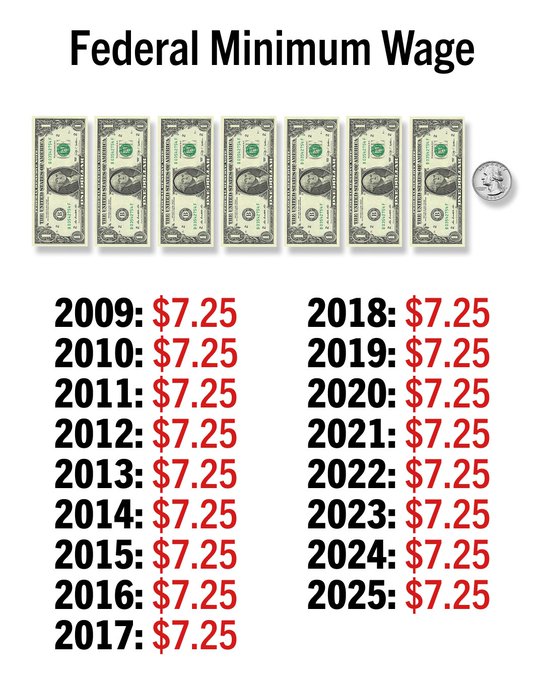In 2009, the federal minimum wage was set at $7.25 an hour, and for the mortgage field services industry, that number became not just a benchmark, but a ceiling. What was once the floor is now the lid on labor compensation, particularly for Inspectors who conduct occupancy checks, photograph properties, and generate condition reports for financial institutions and federal housing authorities. Today, in 2025, while the price of everything from bread to brake pads has soared, the rate paid for a single inspection remains stubbornly tethered to a wage metric born out of the Great Recession. For an industry that continues to rely on the decentralized, gig-based workforce of Inspectors and Field Service Technicians, the refusal to adjust compensation in line with inflation is not merely negligent—it is exploitative.
For Field Service Technicians, the situation is no better. These are the men and women who cut the overgrown grass, secure broken doors, remove garbage, and winterize abandoned homes. They carry the brunt of the physical workload in the mortgage field services industry. And while some may claim they are paid per job rather than per hour, the math is simple. A grass cut that paid $25 in 2009 still pays $25 today, despite the cost of gasoline having risen from roughly $2.40 per gallon to an average of $3.95 nationwide in mid-2025. Mowers, trailers, and insurance costs have all followed suit. The net result is that Field Service Technicians are frequently making below minimum wage once labor time, travel, fuel, and materials are factored in.
Rent is another glaring example. According to the U.S. Department of Housing and Urban Development, the fair market rent for a one-bedroom apartment in 2009 hovered around $700 in many regions. In 2025, that number has ballooned to over $2,300 in those same areas, with urban zones often exceeding $3,000. The industry’s refusal to scale pay to reflect this reality means that many Inspectors and Field Service Technicians are one emergency away from eviction. Some have resorted to living out of their vehicles, ironically while photographing the decaying remains of homes others once lived in.
Grocery bills tell a similar tale. The average cost of a loaf of bread in 2009 was $1.98. In 2025, that cost now averages $3.89. A dozen eggs, which once hovered around $1.75, regularly exceeds $4.50. Family-size grocery hauls that used to stretch $100 are now easily tipping $350. Meanwhile, those performing occupancy inspections for banks are still being paid the same flat $7.25 fee—often netting less after accounting for taxes, mobile app fees, and required compliance tools.
Vehicle costs, critical for both Inspectors and Field Service Technicians, have escalated far beyond inflation. The average price of a used truck in 2009 was under $20,000. Today, it is not uncommon to see modest work vehicles priced at $30,000 to $40,000. Repair costs have also climbed sharply, due to both supply chain issues and labor shortages in the auto sector. In an industry dependent on reliable transportation, the cost of simply showing up for work has become unsustainable for many.
Health insurance, another mandatory expense for independent contractors, has become increasingly unattainable. A basic private health plan that might have cost $200 per month in 2009 now easily runs over $500 for individuals and exceeds $1,200 for families. Because the field services industry misclassifies nearly all of its workforce as independent contractors, Inspectors and Field Service Technicians receive no employer contributions. This alone disqualifies many from seeking preventative or emergency care, an issue compounded by the physical nature of the work and the geographical isolation of many job sites.
The mortgage payment gap is perhaps the cruelest irony. A 30-year fixed-rate mortgage on a $150,000 home in 2009 carried an interest rate of around 5 percent, translating to roughly $805 per month. In 2025, the average home price has eclipsed $430,000 and interest rates have hovered near 7 percent, pushing monthly payments beyond $2,600. These are homes that Inspectors and Field Service Technicians will never own, even as they are dispatched to preserve, inspect, and catalog them for institutional stakeholders who profit from foreclosures and bank-owned properties.
The stagnation in pay stands in stark contrast to the profits being reported by financial institutions, asset management firms, and the order mills who broker the labor. Large servicers like MCS, Cyprexx, and ZVN Properties continue to report healthy balance sheets. Yet those performing the physical and logistical groundwork—the very foundation of the industry’s operations—are increasingly impoverished. Without wage increases, labor shortages will deepen. Already, many longtime Inspectors and Technicians have exited the field, citing burnout, dangerous working conditions, and the unsustainable economic calculus of participation.
Compounding the issue is the increasingly digital infrastructure imposed on the labor force. Companies require laborers to utilize proprietary apps, GPS check-ins, and photo timestamping—all without compensation for device wear, data costs, or technical training. The cost of compliance with this digital leash, coupled with the already thin margins, has made the work less appealing than entry-level positions at fast food restaurants, many of which now pay $17 or more per hour.
The industry’s position, often cloaked in the language of “cost control” and “client expectations,” rings hollow against this backdrop. There has been no cost control for food, fuel, rent, or insurance. There has been no expectation reset for homeowners or tenants. And there is certainly no downward pressure on the fees charged by servicers to the banks. What exists is a labor caste, artificially devalued, and systemically restrained from organizing or negotiating.
Until the mortgage field services industry reconciles the economic realities of 2025 with the outdated labor rates of 2009, the workforce will continue to erode. Field Service Technicians and Inspectors have asked for luxury, only to put food on the table. They are demanding survival. The $7.25 inspection is not just a symbol of stagnation—it is an indictment of an industry built upon the extraction of value from laborers without reciprocity. The question remains: how long can this imbalance persist before the system collapses under its own weight? Or worse, how many more must be crushed beneath it before anyone in management is held accountable?









